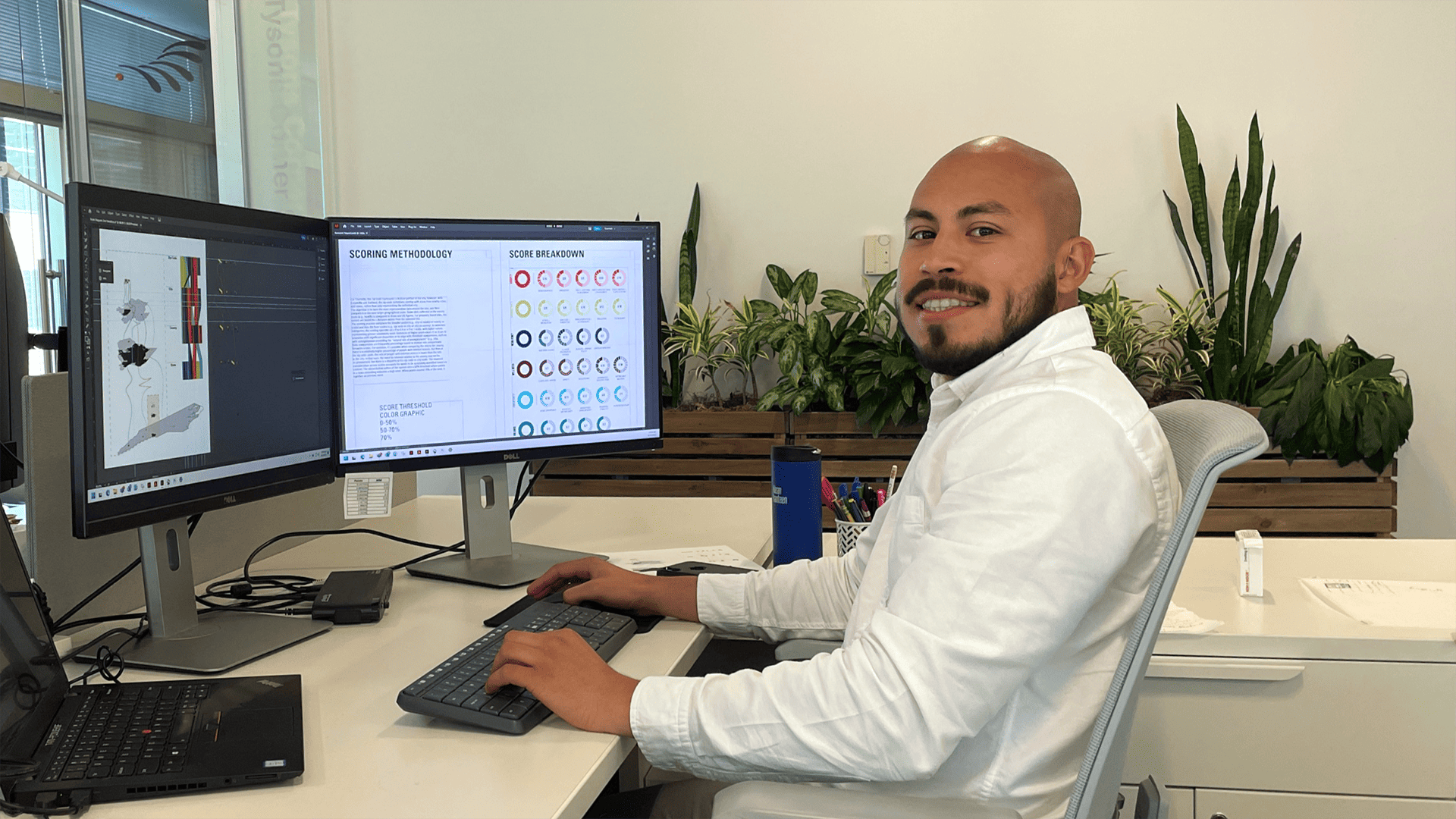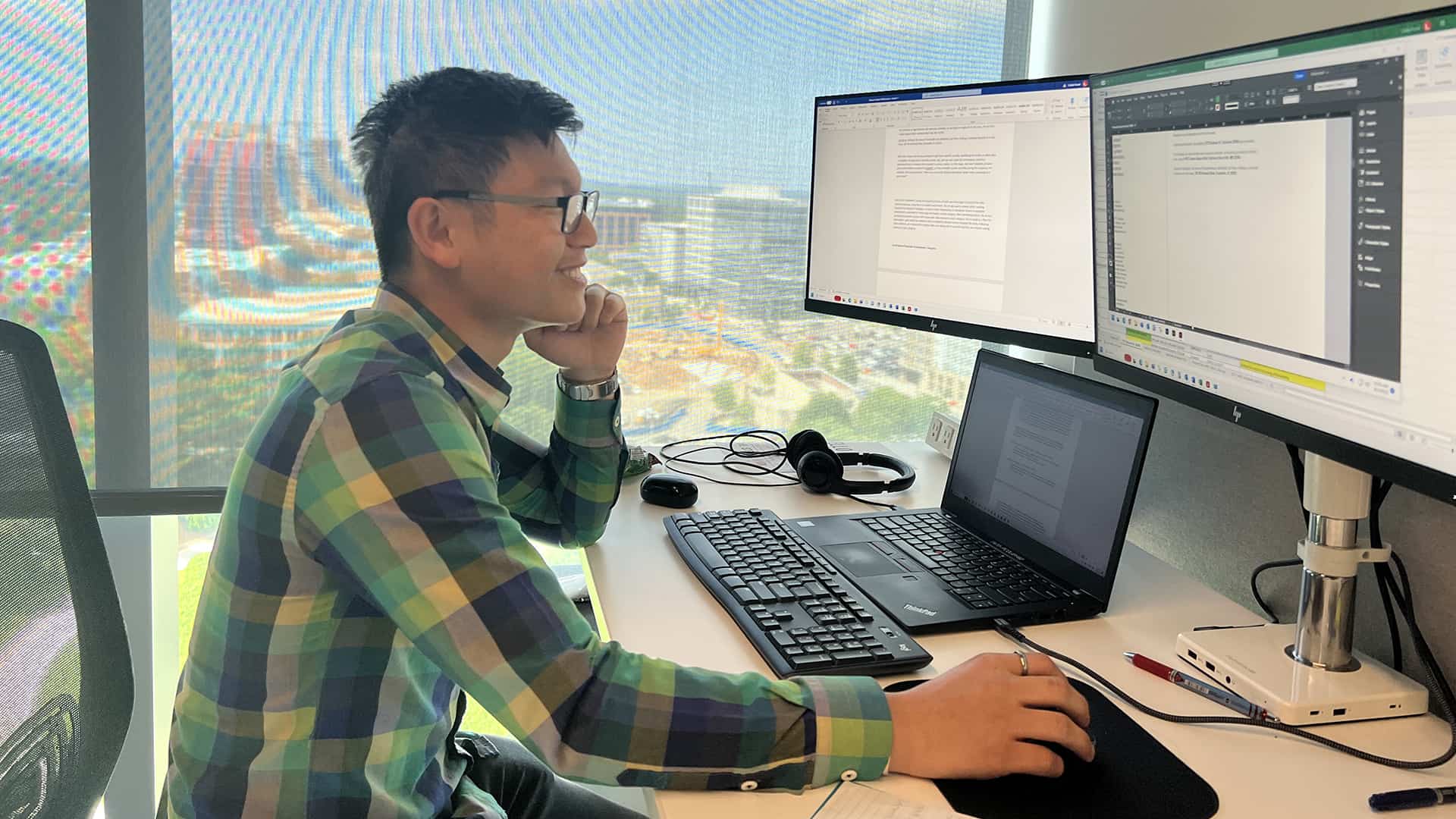The National Organization of Minority Architects (NOMA) fellowship program NOMA Future Faces (NFF) creates an environment for a more equitable future. It not only creates a path for minorities to gain valuable professional experience but also invests in a more regenerative workplace community. A resilient team achieves this by utilizing positive methods to enhance well-being, actively propelling the culture’s growth, and nurturing ownership and collaboration among its members.
NOMA FUTURE FACES FELLOWS AT LITTLE
In the pursuit of fostering a culture of professional growth, I feel honored to coordinate Little’s inaugural year partnering with the NOMA Foundation to provide a transformative experience for two summer fellows prepared to make a meaningful impact on the architectural world.
Through in-depth research, Caleb Kwok and Jordano Hernandez explored the multifaceted dimensions of equity within the built environment, delving into the present-day challenges and the promising path forward. From inclusivity in design to dismantling systemic barriers, the pursuit of equity stands poised to redefine the purpose of architecture and its impact on individuals and communities alike. Throughout this fellowship, Caleb and Jordano have had access to insights from their mentors, Tomas Jiménez-Eliaeson and Jim Thompson, to engage in thought-provoking research and develop a design tool that would positively contribute to the Little’s current design processes.
THE SOCIAL IMPACT TOOL PROJECT
“It has been such a pleasure to have both Jordano and Caleb help bring our summer research project— The Social Impact Tool—to fruition,” shares Design Partner Tomas Jiménez-Eliaeson. “They both have been outstanding: bright, energetic, resourceful, insightful, inspiring, and amazingly collaborative.”
Jordano and Caleb entered the fellowship with open eyes and minds, in addition to having great backgrounds and ideas. From the very beginning, they understood the goal of the research project and took the outline and analyzed it, dissected it, questioned it, and elevated it. Their experience and previous learning helped evolve the research to high levels in just two short months.
“Especially impressive was their capability to accomplish a tool to identify, collect, and gauge multiple data points that will be used to determine the social impact opportunities of a specific project on a specific site,” continues Tomas. “Jordano and Caleb completed a wonderful project that Little will use in beta testing over the next few months and will be shared at conferences including NOMA and the AIA Conference on Architecture. As a result, we are hiring Jordano full time and are hopeful that Caleb will join Little in the future.”
BENEFITS OF THE NFF FELLOWSHIP
This fellowship has helped foster connections with a diverse network of professionals, researchers, and experts. These interactions have not only deepened Caleb and Jordano’s understanding of architecture but have also enriched their perspective on collaborative problem-solving and the broader impact of their work. As we look forward, we hope to continue creating spaces and nurturing the momentum toward a better future guided by our firm’s values of Care, Stretch, and Spark.
We surveyed each fellow to elaborate on their accomplishments, challenges overcome, and the growth that has resulted from this enriching experience.
MEET JORDANO HERNANDEZ

What initially drew you to select Little as your NFF host firm for this summer?
I had become aware of Little as an applicant of NFF in 2022 and appreciated that the firm functions as transdisciplinary practice. I was not initially familiar with what a transdisciplinary practice was, but after reading into it, I came to realize it is an important distinction to make from a multi-disciplinary practice. A model that enables long-lasting impact rather than short-term solutions is a value I share.
What did you work on throughout the duration of your fellowship?
I had the pleasure of being exposed to the process of preparing for a client interview by constructing a topography model of the proposed site of a recreation center. I also prepared a digital model for the schematic design of a terrace project and enjoyed co-investigating and developing a prototype social equity tool to be used internally for assisting with design development and community engagement.
Did you feel that the NOMA Future Faces fellowship was helpful in your professional development?
I believe that the NOMA Future Faces fellowship opened a door that would otherwise have been closed to me. I have had great experiences within my fellowship experience. The opportunity to connect with design professionals and contribute to important conversations involving resiliency, and the strategic planning around technological development is tremendous.
What advice would you have for other individuals pursuing or experiencing their first internship experience?
Communication is very important. Working to develop a mindfulness that enables effective communication (sensitive to your own constitution) will greatly impact your ability to navigate a new workplace. Asking questions and being present opens doors to opportunities you may not have known were available. One task of the internship is learning to advocate for oneself—what do you want for your career? Understand that communication takes time, and resolutions require patience (unless they are the urgent kind … but, probably still demand patience).
Knowing what you know now, what are your plans next?
It’s required to have completed 200 jumps to skydive with a wingsuit, so I will be focusing on other hobbies instead. I will also be working within the Retail studio at Little starting August 28.
MEET CALEB KWOK

What initially drew you to select Little as your NFF host firm for this summer?
During the interview stage, Daniel, Tomas, and JT were very friendly. It didn’t feel high pressure, but more like natural conversations about topics that interested us. I could tell I would be able to learn from them, while being able to contribute my thoughts and ideas for the project I was tasked to work on.
What did you work on throughout the duration of your fellowship?
During the fellowship, the primary project I worked on was a research project looking at how the firm could approach social equity. The study focused on site analysis and assessment, investigating the different factors that influence equity and development and how architects play a role in creating positive social impact. I tested how AI tools could assist in the data collection process, and then once we had the information, we worked on presenting the data in an understandable manner where we can show how architects can create positive social impact.
Did you feel that the NOMA Future Faces fellowship was helpful in your professional development?
The NOMA Future Faces fellowship provided me the opportunity to experience a new city and firm. I feel like this opportunity provided a new perspective into the profession and allowed me to interact with a variety of people with different interests within the umbrella of an architecture firm. I really appreciate being able to work with Tomas and sit next to JT. They are leaders within the firm but were always accessible. I enjoyed our conversations and learning from them, especially because of their passion for the work they do.
What advice would you have for other individuals pursuing or experiencing their first internship experience?
When applying and deciding between firms, think about what you value and what you want to learn. Internships are a great opportunity to explore the different parts of the profession. Actively seek involvement and don’t be afraid to ask questions, especially if you are curious. Also, when you have an idea or other way to contribute, speak up. You will see that the best firms will listen and value your input, even if you are an intern.
Knowing what you know now, what are your plans next?
Following this internship experience, I have two more years of school remaining, and I plan to pursue licensure while working in Chicago. The research project allowed me to investigate the different ways architects can have an impact beyond a single project, and after being at Little, I know I want to work somewhere I can leave a positive impact for communities. I plan to do public projects like schools, libraries, and museums that provide a place for people to gather, because I believe those spaces can provide education and other opportunities for a community to grow together.

